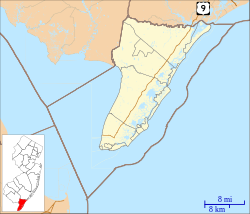Cold Spring Presbyterian Cemetery, Cape May
|
Cold Spring Presbyterian Church
|
|
 |
|
| Location | Cold Spring, New Jersey |
|---|---|
| Coordinates | 38°58′35.26″N 74°54′59.11″W / 38.9764611°N 74.9164194°WCoordinates: 38°58′35.26″N 74°54′59.11″W / 38.9764611°N 74.9164194°W |
| Built | 1823 |
| Architect | Thomas Hurst Hughes |
| Architectural style | Federal |
| NRHP reference # | 91000785 |
| Added to NRHP | June 14, 1991 |
The Cold Spring Presbyterian Church, located on Seashore Road in the Cold Spring section of Cape May, in Cape May County, New Jersey, United States, is a historic two-story church on the National Register of Historic Places. The current church building, known as "Old Brick", was constructed in 1823 by Thomas H. Hughes, who was also the architect of Congress Hall in Cape May, New Jersey. This red brick building replaced a frame and shingle church erected in 1764, which itself replaced a 1714 log meetinghouse. The church's cemetery is the site of a 1742 grave (that of Sarah Eldridge Spicer) and of the most Mayflower descendants anywhere outside Massachusetts.
The congregation was founded in 1714, following the settlement of the area by Connecticut Presbyterians. The first regular pastor was the Rev. John Bradner, who served from 1715 until 1721, when he moved to Goshen in Orange County, New York. The Rev. Hughston Hughes served as pastor for one year, starting in 1726, before being dismissed for "his too free use of intoxicating drinks."
The Rev. Samuel Finley served as pastor for several years. Finley, who was a graduate of the Log College, later became president of the College of New Jersey, the predecessor of Princeton University. Another Log College graduate, the Rev. Daniel Lawrence, served as pastor from 1752 until his death in 1766. His tombstone in the adjacent graveyard was inscribed
In yonder sacred house I spent my breath,
Now, silent, mouldering here I lie in death,
Those silent lips shall wake and yet declare,
A dread amen to truths they publish there
The two hundredth anniversary of the church was celebrated on August 16, 1914. John Wanamaker, who attended when a child, contributed generously to the endowment fund. President Woodrow Wilson sent a congratulatory letter.
...
Wikipedia



